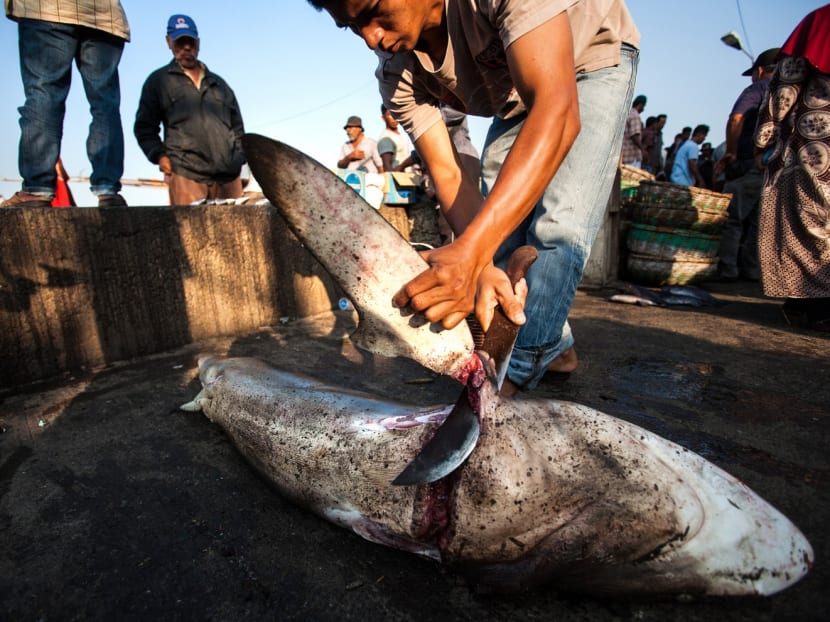Singapore edging up as world’s second-largest shark’s fin trader
SINGAPORE — Despite various moves here in recent years, such as hotels removing shark’s fin from their restaurant menus, for example, Singapore has moved up the ranks to become the world’s second-biggest trader of the product, a report has found.

An Indonesian fisherman cuts the fin of a shark in Lampulo fish market in Banda Aceh in Aceh province on March 7, 2013. Photo: AFP
SINGAPORE — Despite various moves here in recent years, such as hotels removing shark’s fin from their restaurant menus, for example, Singapore has moved up the ranks to become the world’s second-biggest trader of the product, a report has found.
Traffic, a wildlife-trade monitoring network, and the World Wide Fund for Nature (WWF), which published the report, noted that an in-depth analysis of the trade here was hampered by a lack of detail in the Singapore Customs’ import and export data.
They urged the government department to begin recording data on the trade using the internationally recognised harmonised system (HS) codes developed by the World Customs Organisation, and the Agri-Food and Veterinary Authority of Singapore (AVA) has told them that this was under way. The use of HS codes to classify goods, including shark commodities, was introduced in 1967, Singapore Customs told TODAY.
The report indicated that Singapore should “immediately scrutinise” its practices including its HS codes, which do not distinguish the different types of shark products or provide for all protected species.
The analysis of Singapore’s role in the shark and ray trade found that, on the export front, the country placed second after Hong Kong, with trade valued at US$40 million (S$55 million) between 2012 and 2013.
This was 11.1 per cent lower than Hong Kong’s US$45 million. Singapore is also the second-largest importer of shark’s fin after Hong Kong. Imports over the same period were valued at US$51.4 million, compared with Hong Kong’s US$170 million. As a re-exporter of the product, Singapore is placed second as well, averaging 2,422 tonnes yearly between 2012 and 2013 — which is one-tenth of the world’s total exports. It re-exported the commodity to countries such as Hong Kong, China and Japan.
A Traffic report in 2013 showed that Singapore was one of the world’s top four exporters and the third-largest importer of shark’s fin between 2000 and 2009.
In recent years, businesses from hotels to airlines have taken steps to stem the trade. In 2014, Singapore Airlines Cargo stopped carrying shark’s fin on its flights. That year, hotel giants, including Hilton, also said no to dishing out the ingredient at the properties they own and manage.
In their report, Traffic and the WWF said that more detailed codes would allow shark products to be distinguished between “dried” and “frozen”, which is crucial to determining trade volumes accurately.
The two groups have started discussions with the AVA to put in place product commodity codes for all
30 species of sharks and rays that are subject to international trade restrictions under the Convention on the International Trade in Endangered Species of Wild Fauna and Flora.
Such information would also allow individuals and firms to make “responsible” choices on the products they consume or use, they added.
The impact of hunting sharks for their fins has been the subject of much debate. More than 70 million sharks are killed yearly across the globe, and many species are caught at “unsustainable levels”, Traffic and the WWF said.








